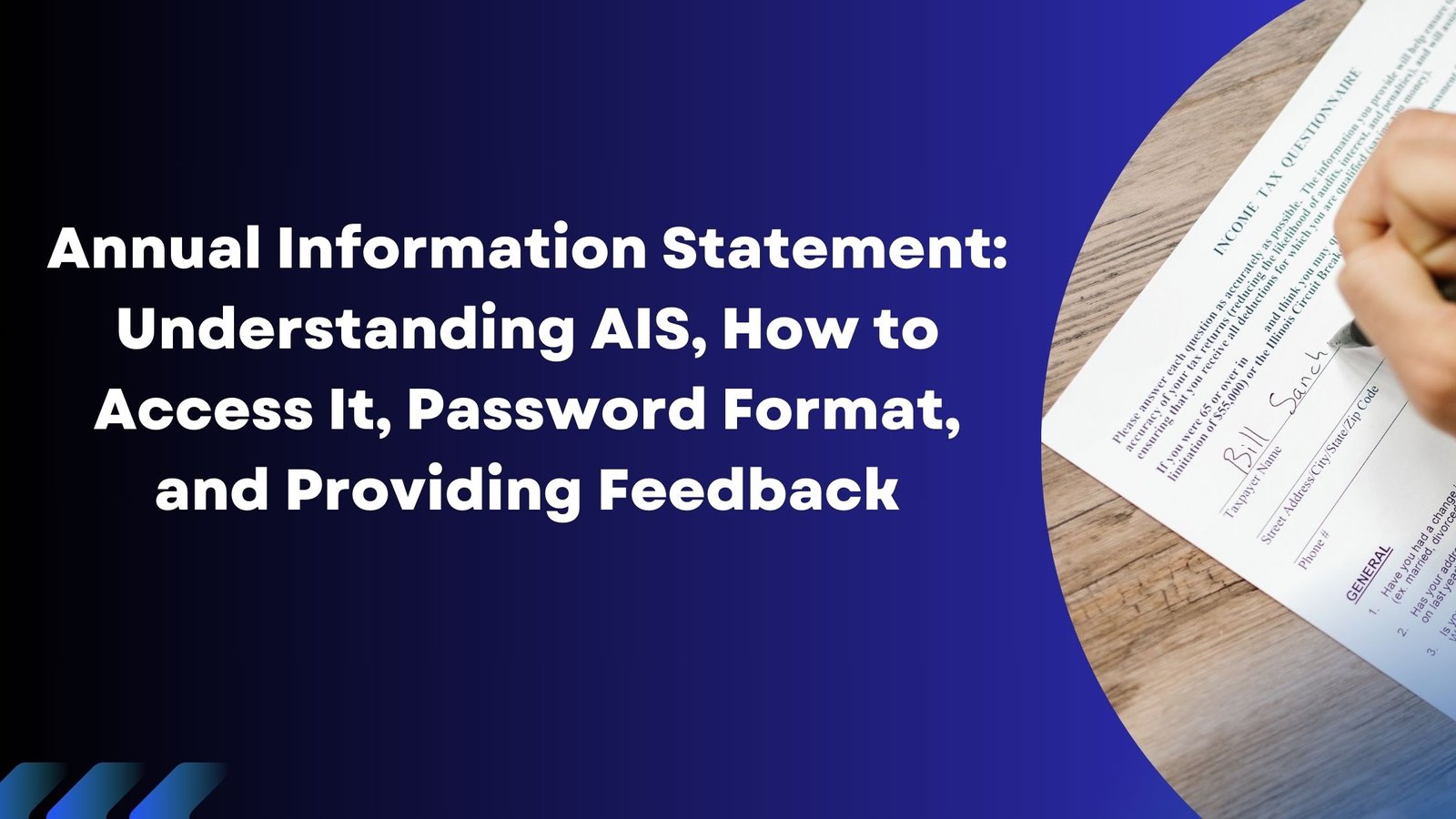
The Annual Information Statement (AIS) provides a comprehensive overview of a taxpayer’s financial data by showing both the reported values (submitted by reporting entities) and the modified values (adjusted based on the taxpayer’s feedback). This includes information such as TDS, Statement of Financial Transactions (SFT), and other relevant financial details.
Purpose of AIS
The AIS was introduced with the following objectives:
- Display Comprehensive Information: It offers taxpayers a complete view of their financial data while allowing them to provide online feedback.
- Encourage Voluntary Compliance: The AIS aims to reduce underreporting of income by facilitating easier compliance for taxpayers.
- Enhance Pre-filing of Returns: By providing accurate and updated information, the AIS enables seamless pre-filing of income tax returns.
- Promote Compliance: It acts as a deterrent to non-compliance by providing clear and transparent financial data.
Key Features of AIS
- New Financial Data: The AIS includes information on interest, dividends, securities transactions, mutual fund transactions, foreign remittances, and more.
- Taxpayer Information Summary (TIS): This is a summarized version of the AIS, making it easier to file returns by pre-filling the necessary information.
- Feedback Mechanism: Taxpayers can provide feedback on the information presented in the AIS and download their data in various formats, including PDF, JSON, and CSV.
- AIS Utility: This tool allows taxpayers to view their AIS and submit feedback offline.
Understanding the Taxpayer Information Summary (TIS)
The TIS provides a category-wise summary for each taxpayer, showing both the processed value (after data deduplication) and the derived value (after considering feedback). This derived information is then used to pre-fill the taxpayer’s income tax returns.
Steps to Access Your Annual Information Statement (AIS)
- Login to the Income Tax E-filing Portal: Visit the official income tax website at www.incometax.gov.in and log in to your account. Navigate to the ‘AIS’ section.
2. Proceed to the Compliance Portal: Click the ‘Proceed’ button, which will redirect you to the compliance portal.
3. View TIS and AIS: On the AIS homepage, you can view both the Taxpayer Information Summary (TIS) and the Annual Information Statement (AIS).
4. Select the Financial Year: Choose the relevant financial year and click on the appropriate tiles to view your TIS or AIS.
You can view the screenshot of the TIS summary.
View below screenshot of AIS
5. Download AIS and TIS: You can download the TIS in PDF format and the AIS in PDF or JSON formats by clicking the download icon.
AIS PDF Password: How to Open Your AIS PDF
When you download the AIS in PDF format, it will be password protected. The password is a combination of your PAN (in lowercase) and your date of birth (for individuals) or date of incorporation/formation (for non-individuals) in the format DDMMYYYY without spaces.
Eg: If PAN: AAAPK1742B and Date of Birth: 01-05-1985
then, Password for AIS & TIS Pdf is: aaapk1742b01051985
Types of Information Displayed in AIS
The AIS is divided into two parts: Part A and Part B.
PART A: General Information
This section includes basic information such as PAN, masked Aadhaar number, name, date of birth/incorporation/formation, and contact details.
PART B: Detailed Financial Information
- TDS/TCS Information: Displays details of tax deducted or collected at source, including information codes, descriptions, and values.
- SFT Information: Information from reporting entities under the Statement of Financial Transactions (SFT), including SFT codes and values.
- Payment of Taxes: Details about taxes paid, such as advance tax and self-assessment tax.
- Demand and Refund: Information about demands raised and refunds issued during the financial year.
- Other Information: Additional data from various sources, such as salary details, interest on refunds, and outward foreign remittances.
The AIS provides a clear and detailed breakdown of each type of financial information, including transaction counts, dates, and amounts.
By understanding and utilizing the AIS, taxpayers can ensure accurate and complete reporting of their financial information, leading to a smoother tax filing process and better compliance with tax regulations.
The Central Board of Direct Taxes (CBDT) has notified 57 different types of income and expenses that will be reflected in the Annual Information Statement (AIS). Here are the types of income and expenses that will be included:
- Salary
- Rent Received
- Dividend
- Interest from Savings Bank
- Interest from Deposits
- Interest from Others
- Interest from Income Tax Refund
- Rent on Plant & Machinery
- Lottery/Crossword Winnings under Section 115BB
- Horse Race Winnings under Section 115BB
- PF Balance from Employer under Section 111
- Infrastructure Debt Fund Interest under Section 115A(1)(a)(ia)
- Interest from Specified Company (Non-Resident) under Section 115A(1)(a)(aa)
- Interest from Bonds/Government Securities
- Units of Non-Resident Income under Section 115A(1)(a)(ab)
- Income/Long-Term Capital Gain from Offshore Fund under Section 115AB(1)(b)
- Income from Foreign Currency Bonds/Shares under Section 115AC
- Income from Securities of Foreign Institutional Investors under Section 115AD(1)(1)
- Income from Specified Fund Securities under Section 115AD(1)(1)
- Insurance Commission
- Life Insurance Policy Receipts
- Online Games Winnings under Section 115BBJ
- Withdrawal from National Savings Scheme
- Lottery Ticket Sales Commission
- Investment Income from Securitization Trust
- Repurchase of Units by Mutual Funds/UTI
- Sums Payable by the Government
- Specified Income of Senior Citizens
- Sale of Land/Building
- Receipts from Transfer of Immovable Property
- Sale of Vehicles
- Sale of Securities/Mutual Fund Units
- Off-Market Debit Transactions
- Off-Market Credit Transactions
- Business Receipts
- GST Turnover
- GST Purchases
- Business Expenses
- Rent Payment
- Miscellaneous Payment
- Cash Deposits
- Cash Withdrawals
- Cash Payments
- Foreign Remittance/Foreign Currency Purchase
- Receipt of Foreign Remittance
- Payment to Non-Resident Sportsmen/Sports Association under Section 115BA
- Foreign Travel
- Purchase of Immovable Property
- Purchase of Vehicles
- Purchase of Time Deposits
- Purchase of Securities/Mutual Funds
- Credit/Debit Card Transactions
- Account Balance
- Distributed Income from Business Trust
- Distributed Income from Investment Fund
- Donations Received
- Receipts from Transfer of Virtual Digital Assets
These categories cover a broad range of financial transactions and activities, ensuring that taxpayers have a comprehensive view of their financial dealings as reported in their AIS. For any queries, contact us!
Difference Between AIS and Form 26AS
Form 26AS and Annual Information Statement (AIS) serve different purposes and offer varying levels of detail about a taxpayer’s financial transactions. Here’s how they differ:
- Details Provided:
- Form 26AS primarily shows TDS/TCS transactions, property purchases, and high-value investments made during the financial year.
- AIS offers a more comprehensive view, including savings account interest, securities/immovable property transactions, foreign remittances, interest on deposits, and more. AIS presents data both in aggregate and on an individual transaction basis.
- Example of Differences:
- If a taxpayer earns Rs 1,700 in savings account interest and Rs 42,000 in interest on deposits from XYZ Bank, Form 26AS will only display the Rs 42,000 deposit interest details (where TDS is deducted).
- In contrast, AIS will show both the savings account interest and the deposit interest, along with details like the bank name, account number, and account type.
- Coverage:
- AIS encompasses TDS/TCS transactions, SFT information, tax payments, demand/refund details, and other relevant financial information.
- Form 26AS also includes GST turnover details (based on GSTR-3B), which are not reflected in AIS.
How to Submit Feedback in AIS? How to Rectify Errors in AIS?
If there are any discrepancies in the AIS, taxpayers have the option to submit feedback and rectify errors. Here’s how to do it:
- Accessing AIS:
- Log in to the Income Tax e-filing portal and navigate to the AIS tab.
- You’ll find sections like TDS/TCS information, SFT information, tax payments, demands and refunds, and other financial information.
- Submitting Feedback:
- For instance, if you need to correct information under the SFT section, expand the relevant category.
- Click on the “Optional” button to submit your feedback on the specific information.
It will ask you to choose the feedback type.
When you submit feedback in the AIS, you will be prompted to choose a feedback type.
Once submitted, the system will reflect the modified figure in brackets.
The derived value is then used to prefill the ITR form of the taxpayer.
AIS Correction Status Update
As of May 13th, 2024, the Central Board of Direct Taxes (CBDT) has introduced a new feature that tracks the status of AIS corrections or feedback submitted by taxpayers. This functionality provides transparency by showing whether the feedback has been partially or fully accepted, or rejected by the Source (the person responsible for uploading the information in AIS).
The status updates you will see include:
- Feedback Shared for Confirmation: Indicates whether your feedback has been sent to the Reporting Source for confirmation.
- Feedback Shared On: Shows the date your feedback was shared with the Reporting Source.
- Source Responded On: Displays the date the Reporting Source responded to your feedback.
- Source Response: Reveals the response provided by the Source, indicating whether any corrections are needed.
This new feature enhances transparency and streamlines the compliance process, further improving taxpayer services.
What to Do If There Is an Error in AIS or Form 26AS?
The AIS reflects information currently available with the Income Tax Department. Certain entities are required by law to report high-value transactions, and this data is included in the AIS once received. However, there might be cases where data for a specific period is not updated or received. Therefore, it is crucial for taxpayers to thoroughly review the information and ensure it is accurate when filing their income tax returns.
If you find errors in your AIS, it is essential to report them through the feedback mechanism outlined earlier. This is especially important, as the Income Tax Department recently identified 68,000 cases of mismatches between AIS and ITR, which are treated as underreporting of income. Failure to correct these errors could result in penalties and interest.
Which Form Should a Taxpayer Refer to When Filing an ITR?
If there is a discrepancy between the information in Form 26AS and AIS, particularly concerning TDS, TCS, or tax paid details, taxpayers should rely on Form 26AS when filing their return. However, if you have already filed your income tax return and discover additional information in AIS, you have the option to revise your return based on the AIS data. This ensures that your return reflects all accurate and updated information.

